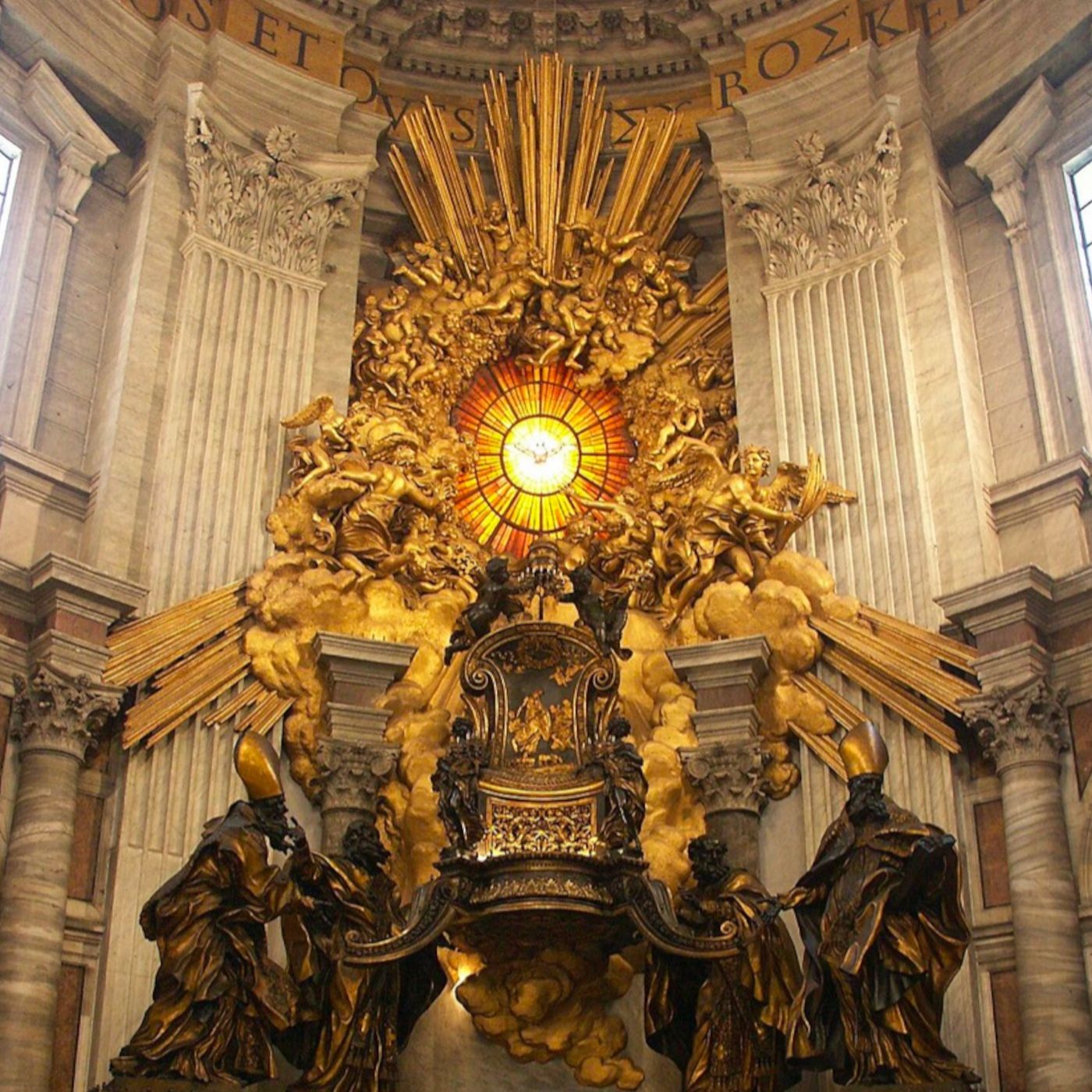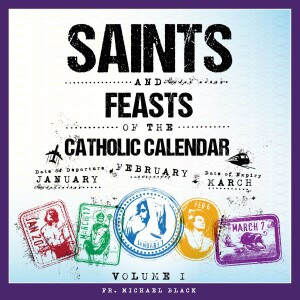
February 22: Chair of Saint Peter, Apostle
Feast; Liturgical Color: White
The gift of authority serves order and truth in the Church
It’s unusual to have a feast day for a chair. When we think of a chair, perhaps we think of a soft recliner into which our body sinks as if into a warm bath. Or our mind turns to a classroom chair, a chair in a waiting room, or one at a restaurant. But the chair the Church commemorates today is more like the heroic-sized marble chair which holds the giant body of President Lincoln in the Lincoln Memorial. We commemorate today a chair like the judge’s in a courtroom or that unique high-backed chair called a throne. These are not ordinary chairs. They are seats of authority and judgment. They hold power more than people. We stand before them while their occupants sit. Judges and kings retire or die, but chairs and thrones remain to hold their successors. The Nicene Creed even describes Jesus as “seated” at God’s right hand. The fuller, symbolic meaning of the word “chair” is what today’s feast commemorates.
Against the farthest wall of Saint Peter’s Basilica in Rome is not a statue of Saint Peter, as one might imagine, but a heroic-sized sculpture framing a chair. To celebrate the Chair of St. Peter is to celebrate the unity of the Church. The chair is a symbol of Saint Peter’s authority, and that authority is not meant for conquest like military power. Ecclesiastical authority is directed toward unity.
Jesus Christ could have gathered an unorganized group of disciples united only by their common love of Him. He didn’t. He could have written the Bible Himself, handed it to His followers, and said, “Obey this text.” He didn’t. Jesus called to Himself, by name, twelve men. He endowed them with the same powers He possessed and left this organized band of brothers as an identifiable, priestly fraternity specifically commissioned to baptize and to preach. In North Africa at the time of Saint Augustine, twelve co-consecrating bishops were canonically required at the ordination of a bishop, mirroring “The Twelve” called by Christ. What a profound liturgical custom! Today the Church requires only three co-consecrators.
What is even more striking about Christ’s establishment of an orderly Church structure is its double organizing principle. The Twelve’s headship over the many is itself subjected to the headship of Saint Peter. He is the keeper of the keys, the rock upon which the Lord built His Church. This all makes sense. What good would a constitution be without a Supreme Court to adjudicate disputes over its interpretation? Any authoritative text needs a living body to stand over it to arbitrate, interpret, and define, with authority equal to the text itself, any and all misinterpretations, confusions, or honest disputes. Just as a constitution needs a court, the Bible needs a Magisterium. And that Magisterium, in turn, needs a head as well.
The authority of the papal office, doctrinally, is a negative charism preserving the Church from teaching error. It is not a guarantee that the pope will teach, explain, or live the faith perfectly. Christ guaranteed that the gates of hell would not prevail against the Church. That’s a negative promise. But this promise also prophesies that the Office of Peter will be a lightning rod absorbing strikes from the forces of evil, that this Church, and no other, will be the target of the darkest of powers. A real Church has real enemies.
The Church has never had an Office of Saint Paul. When the person of Paul disappeared, so did his specific role. But the Office of Peter continues, as does the Office of all the Apostles. In other words, the Church has both a foundation and a structure built on that foundation. And authority in that structure is not transmitted personally, from father to son or from one family to the next. Authority attaches to the Office of St. Peter and endows its occupant with the charisms promised by Christ to Saint Peter. And this charism will endure until the sun sets for the last time. As long as there is a Church, it will teach objective truth guaranteed by objective leadership. And that leadership, symbolized in the Chair of St. Peter, is directed toward unity. One Lord. One faith. One Shepherd. One flock. The united fabric of the Church, so fought for, so torn, so necessary, is what we honor today.
God in Heaven, we thank You for the ordered community of faith we enjoy in the Church. Saint Peter guided the early Church and guides Her still, ensuring that we remain one, holy, catholic, and apostolic until the end of time. Continue to grace Your Church with the unity so necessary to accomplish Her mission on earth.
view more
Feast; Liturgical Color: White
The gift of authority serves order and truth in the Church
It’s unusual to have a feast day for a chair. When we think of a chair, perhaps we think of a soft recliner into which our body sinks as if into a warm bath. Or our mind turns to a classroom chair, a chair in a waiting room, or one at a restaurant. But the chair the Church commemorates today is more like the heroic-sized marble chair which holds the giant body of President Lincoln in the Lincoln Memorial. We commemorate today a chair like the judge’s in a courtroom or that unique high-backed chair called a throne. These are not ordinary chairs. They are seats of authority and judgment. They hold power more than people. We stand before them while their occupants sit. Judges and kings retire or die, but chairs and thrones remain to hold their successors. The Nicene Creed even describes Jesus as “seated” at God’s right hand. The fuller, symbolic meaning of the word “chair” is what today’s feast commemorates.
Against the farthest wall of Saint Peter’s Basilica in Rome is not a statue of Saint Peter, as one might imagine, but a heroic-sized sculpture framing a chair. To celebrate the Chair of St. Peter is to celebrate the unity of the Church. The chair is a symbol of Saint Peter’s authority, and that authority is not meant for conquest like military power. Ecclesiastical authority is directed toward unity.
Jesus Christ could have gathered an unorganized group of disciples united only by their common love of Him. He didn’t. He could have written the Bible Himself, handed it to His followers, and said, “Obey this text.” He didn’t. Jesus called to Himself, by name, twelve men. He endowed them with the same powers He possessed and left this organized band of brothers as an identifiable, priestly fraternity specifically commissioned to baptize and to preach. In North Africa at the time of Saint Augustine, twelve co-consecrating bishops were canonically required at the ordination of a bishop, mirroring “The Twelve” called by Christ. What a profound liturgical custom! Today the Church requires only three co-consecrators.
What is even more striking about Christ’s establishment of an orderly Church structure is its double organizing principle. The Twelve’s headship over the many is itself subjected to the headship of Saint Peter. He is the keeper of the keys, the rock upon which the Lord built His Church. This all makes sense. What good would a constitution be without a Supreme Court to adjudicate disputes over its interpretation? Any authoritative text needs a living body to stand over it to arbitrate, interpret, and define, with authority equal to the text itself, any and all misinterpretations, confusions, or honest disputes. Just as a constitution needs a court, the Bible needs a Magisterium. And that Magisterium, in turn, needs a head as well.
The authority of the papal office, doctrinally, is a negative charism preserving the Church from teaching error. It is not a guarantee that the pope will teach, explain, or live the faith perfectly. Christ guaranteed that the gates of hell would not prevail against the Church. That’s a negative promise. But this promise also prophesies that the Office of Peter will be a lightning rod absorbing strikes from the forces of evil, that this Church, and no other, will be the target of the darkest of powers. A real Church has real enemies.
The Church has never had an Office of Saint Paul. When the person of Paul disappeared, so did his specific role. But the Office of Peter continues, as does the Office of all the Apostles. In other words, the Church has both a foundation and a structure built on that foundation. And authority in that structure is not transmitted personally, from father to son or from one family to the next. Authority attaches to the Office of St. Peter and endows its occupant with the charisms promised by Christ to Saint Peter. And this charism will endure until the sun sets for the last time. As long as there is a Church, it will teach objective truth guaranteed by objective leadership. And that leadership, symbolized in the Chair of St. Peter, is directed toward unity. One Lord. One faith. One Shepherd. One flock. The united fabric of the Church, so fought for, so torn, so necessary, is what we honor today.
God in Heaven, we thank You for the ordered community of faith we enjoy in the Church. Saint Peter guided the early Church and guides Her still, ensuring that we remain one, holy, catholic, and apostolic until the end of time. Continue to grace Your Church with the unity so necessary to accomplish Her mission on earth.
More Episodes
August 23: Saint Rose of Lima, Virgin
 2024-08-23
2024-08-23
 2024-08-23
2024-08-23
August 21: Saint Pius X, Pope
 2024-08-21
2024-08-21
 2024-08-21
2024-08-21
August 19: Saint John Eudes, Priest
 2024-08-17
2024-08-17
 2024-08-17
2024-08-17
August 16: Saint Stephen of Hungary
 2024-08-16
2024-08-16
 2024-08-16
2024-08-16
August 11: Saint Clare, Virgin
 2024-08-11
2024-08-11
 2024-08-11
2024-08-11
August 10: Saint Lawrence, Deacon and Martyr
 2024-08-10
2024-08-10
 2024-08-10
2024-08-10
August 8: Saint Dominic, Priest
 2024-08-08
2024-08-08
 2024-08-08
2024-08-08
August 7: Saint Cajetan, Priest
 2024-08-06
2024-08-06
 2024-08-06
2024-08-06
August 6: The Transfiguration of the Lord
 2024-08-06
2024-08-06
 2024-08-06
2024-08-06
August 4: Saint John Vianney, Priest
 2024-08-03
2024-08-03
 2024-08-03
2024-08-03
August 2: Saint Peter Julian Eymard, Priest
 2024-08-02
2024-08-02
 2024-08-02
2024-08-02
012345678910111213141516171819
Create your
podcast in
minutes
- Full-featured podcast site
- Unlimited storage and bandwidth
- Comprehensive podcast stats
- Distribute to Apple Podcasts, Spotify, and more
- Make money with your podcast
It is Free
- Privacy Policy
- Cookie Policy
- Terms of Use
- Consent Preferences
- Copyright © 2015-2024 Podbean.com






